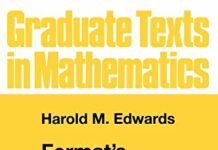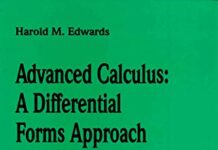
Ebook Info
- Published: 2001
- Number of pages: 336 pages
- Format: PDF
- File Size: 29.66 MB
- Authors: Harold M. Edwards
Description
Bernhard Riemann’s eight-page paper entitled “On the Number of Primes Less Than a Given Magnitude” was a landmark publication of 1859 that directly influenced generations of great mathematicians, among them Hadamard, Landau, Hardy, Siegel, Jensen, Bohr, Selberg, Artin, and Hecke. This text, by a noted mathematician and educator, examines and amplifies the paper itself, and traces the developments in theory inspired by it. (An English translation of the original document appears in the Appendix.)Topics include Riemann’s main formula, the prime number theorem, de la Vallée Poussin’s theorem, numerical analysis of roots by Euler-Maclaurin summation, the Riemann-Siegel formula, largescale computations, Fourier analysis, zeros on the line, the Riemann hypothesis and Farey series, alternative proof of the integral formula, Tauberian theorems, Chebyshev’s identity, and other related topics.This inexpensive edition of Edwards’ superb high-level study will be welcomed by students and mathematicians. Mathematically inclined general readers will likewise value this influential classic.
User’s Reviews
Reviews from Amazon users which were colected at the time this book was published on the website:
⭐This is the classic book on the matter, and I did learn things that I did not already know about it.However, the audience is targeted, it seems, to those with a Math Ph.D. I have an advanced degree in physics, and I am entirely fascinated with the zeta function and study it a lot. But he lost me in places and I see that other readers could not follow him either in places. And thus, I cannot give him top marks.
⭐A classic written about the properties of the Riemann Zeta function and the greatest unsolved mathematical problem this century – the Riemann Hypothesis. If you have your sites on attempting to solve this problem or just interested in understanding the problem , “this book is the definitive starting point.”
⭐I hesitate to add to the chorus of praise here for H.M. Edwards’s “Riemann’s Zeta Function,” for what little mathematics I have is self taught. Nevertheless, after reading John Derbyshire’s gripping “Prime Obsession” and following the math he used there with ease, I thought to tackle a more challenging book on the subject. A Topologist friend suggested Titchmarsh’s “The Theory of the Riemann Zeta-Function,” but I soon bogged down. I happily came across Edwards while browsing, and was pleased both with the low price, and the lucid contents.For those who are mathematicians and like their introductions to the most fascinating math problems straight and touching all horizons of inquiry, then experts appear to have converged on Titchmarsh as the volume for the first string. However, Edward’s work is also appropriate for experts and hits the highlights of background leading to the Zeta function. But Edward’s chief strength is beyond his intended audience, for it is his accessibility for the occasional mathematician. With some patience, and not without some little pain and an occasional side trip to “The World of Mathematics” or “The Encyclopedia of Mathematics,” even a self-trained mathematician can appreciate most of what Edwards is explaining.In short, I heartily recommend to those who have enjoyed John Derbyshire’s “Prime Obsession,” and have additional steam, to take up Edward’s “Riemann’ Zeta Function” volume for further insights and knowledge.
⭐I consider myself more a user of math results than one who really understands math. This book is wonderful because it is not just a compendium of results, but explains the evolution of different areas in math resulting from Riemann’s 8-page paper. I read the first chapter like a dense novel (think Dostoyevsky or Pynchon). I liked it so much that I just order another book by Harold Edwards, the one on “Galois Theory”
⭐The math is over my head but the explanations are helpful and clear and are giving me a good sense of the process a brilliant mathematician goes through in his explorations. I feel like I’m walking around the base camp of Mount Everest getting fantastic glimpses of the mountain above me.
⭐The best book on this topic bar none. Of course it is a sophisticated mathematical treatment, so not for amateurs, but if you are serious about understanding „THE“ paper, this is a wonderful companion.
⭐Very abstract discussion of an unsolved mathematical problem
⭐The popular press leaves us with the impression that math isintimidating. This wasn’t always the case. In my time, the approach to how we teach math went thru cycles: (1) The boot-campapproach with its endless drills, (2) The New-Math approach, (3) The back-to-basics trend, and (4) The Make-it-Seem-Easy-and Fun approach and the motivational speakers.—Finally Edwards suggests, following Eric Temple Bell, that we rather begin with the classics when approaching a subject in math. It was thought that later books based on the classics had more effective ways of doing it, and few took the trouble of looking at the original and central papers of the great masters. The landmark papers. All the while, they collected dust on the shelves in the back rooms of libraries. Of the classics, the true landmarks, one stands out: It is Riemann’s paper on the prime numbers, what later turned into the prime number theorem. It is also the paper with the Riemann hypothesis, still unproved, now generations later. So it is a delightful idea including Riemann’s paper, in translation, in an appendix. It would have been nice had Edwards also reproduced the original German text. Now the RH is one of the Million-Dollar problems in math. It is anyone’s guess when it will be cracked, but in the mean time, it continues to inspire generations of mathematicians and students. This Dover edition is came out in 2001. The original first 1974 edition, Academic Press, had gone out of print. This lovely book seems still to be a model that we can measure other books against. Edwards’ presentation is both engaging and deep, and the book contains the gems in a subject that continues to be central in math, the subject of analytic number theory.
⭐* PhysicalThis book has around 315 pages of standard quality paper with few graphs.* Target audience, H.N.D, undergraduate, graduate, post graduate, Masters?In my opinion, this book as aimed post graduate, Masters level in Mathematical studies.* What’s the best bits?The Zeta function has many forms. It is based on Euler’s Harmonic series; but is used with real and complex power values instead. Euclid stated that every integer number can be made with a unique compound of prime numbers multiplied together. This linkage between using generating series to see when the real and complex numbers change signs is how to to see when a prime is created. This method of attack uses when this breaking down is explored with instead elemental, basic series to make it easier to get along with.These workings will be undertaken using mathematical shorthand using greek letters that help to simplify the math, but this is a skill to be learnt in itself. Its then explained with proofs using these elemental series components and mathematical short hand too in a very dense exploration of this area. One topic earlier on is estimating the density of the number of primes, and how the accuracy has been improved upon again and again.This takes a few chapters that is amazing to go through. Fourier series is partially explored. Some of the formulae are to be taken on faith as this would burden the reader too much.The main burden of math in this book i would is classed as dense. The roots of the Zeta function used with calculating prime numbers is explained and explored to allow the reader to try this out. Its really fun if you keep at it. Amazingly, in the Appendix, page 299 – 305, the translated paper ‘On the Number of Primes less than a Given Magnitude’ written by Bernhard Riemann is included.* Aids to help studying this topicI have been concentrating reading this book for a few months. And i am over halfway through this book. But i have some comprehension and feel like sharing my works so far. It’s taken a lot of time to explore this book. It’s a hell of a lot of topics to take in and explore. It’s been a revelation on appreciating prime numbers, mathematical exploration using a more complex vocabulary using simplified series and topics in proofs and then put together to build upon more concepts.A well known video sharing website has videos which explore the Zeta series that is, in my opinion, recommended and almost mandatory to help in this topic. Another well known website has mathematical applications of Zeta topics through using its own mathematical CADs pages.* SummaryThis book is not my first in the Zeta area. These other books were written for a wider, more general audience, and not this intensive in their strategy. I am not sure if this is the best, the easiest or most relevant. It’s, in my opinion, a deep exploration of this area that does not cover all the fields available to it.Update: I have been reading and studying this book for over 6 months. The time taken is mostly daily and a few hours per day. I have assimilated as much as i can and still not grasped it all. This is a tough topic but is fascinating. i need a break from it as i reached as far as i can at the moment. This break may may make my mind sharp again and not swimming in proofs that are in depth. If you’re doing well, pat yourself on the back for your tenacity!
⭐I bought this book to help with my Mathematics Masters Project on the Riemann Hypothesis and the Riemann Zeta Function.I find the book very useful as it is detailed and clear, and fills in many of the ‘missing’ steps in Bernhard Riemann’s 1859 paper. It has all the topics you would expect to see, and has a particularly good chapter on the analytic continuation of the zeta function, proof of the functional equation and how the zeros of the zeta function link to the primes.A must read for any undergraduate Mathematics student looking to further their understanding. And it’s much cheaper than the alternatives!
⭐Graduate level text. Great if you have a good background in maths.
⭐As described, quick delivery
⭐Gets a bit complicated after the first few pages but I will try to persevere with it.
Keywords
Free Download Riemann’s Zeta Function in PDF format
Riemann’s Zeta Function PDF Free Download
Download Riemann’s Zeta Function 2001 PDF Free
Riemann’s Zeta Function 2001 PDF Free Download
Download Riemann’s Zeta Function PDF
Free Download Ebook Riemann’s Zeta Function





